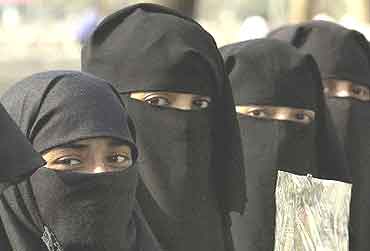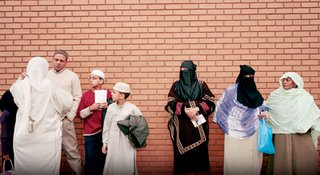
October 24, 2006
"The niqab, or the face veil, terrifies me"
Faith dressed in tribal garb as Muslims debate British ruling on niqab
By Mona Eltahawy
The niqab, or the face veil, terrifies me. I am a Muslim woman for whom the niqab says very little about religion but a whole lot about the erasure of a woman's identity, her very existence as a human being in any society.
I am the first to admit that my views on the niqab are thoroughly grounded as much in my own very personal struggles with the Hijab, which I wore for nine years, as they are more generally with the obsessive focus on how Muslim women dress - an obsession shared by Muslims and non-Muslims alike.
An argument I had years ago - while I still wore Hijab - on the Cairo subway with a woman who wore niqab helped seal for good my refusal to defend the niqab. The woman, dressed in black from head to toe, began by asking me why I did not wear the niqab. I pointed to my headscarf and asked her "Is this not enough?"
I will never forget her answer.
"If you wanted a piece of candy, would you choose an unwrapped piece or one that came in a wrapper?" she asked. "I am not candy," I answered. "Women are not candy."
I have since heard arguments made for the niqab in which the woman is portrayed as a diamond ring or a precious stone and other such objects that need to be hidden as a way of proving their "worth".
And so to this day I unequivocally refuse to defend the niqab, regardless of who is making the argument for or against it. That is especially true in the wake of British House of Commons leader Jack Straw's comments that the niqab prevents communication. He is absolutely right. It prevents a reading of the face and its expressions, vital ingredients in human communication.
While some have grasped Straw's comment as but the latest onslaught against Muslims, others have wisely tried to make the most of the door that Straw kicked down by daring to broach the subject. Just because some British Muslim women wear niqab, it does not become incumbent on every Muslim everywhere to defend the niqab, over which there is no Muslim consensus.
Witness a parallel controversy that erupted in Egypt soon after Straw ignited his firestorm. The dean of Helwan University, south of Cairo, issued an ultimatum warning students they would not be able to stay at college dorms unless they removed their niqab. The dean based his decision on security grounds, saying that men disguised as women in niqab could slip into the female dorms.
In the midst of Egypt's niqab controversy, Soad Saleh, a professor of Islamic law and former dean of the women's faculty of Islamic studies at Al-Azhar University, Egypt, said that the face covering had nothing to do with Islam.
"I don't agree that the veil should be compulsory, and I don't like it," Saleh told Agence France Press. She said she wants to "purge Islam of false concepts: the Quran does not say women have to cover their faces, it's an old Bedouin tradition."
Amnah Nousir, a professor of Islamic philosophy, told the Dubai-based Gulf News that "The niqab was common in the Arabian Peninsula centuries before Islam and was not imposed by this religion."
"The face is one's mirror. So why should the woman hide herself behind this black veil?" she told Gulf News. Gamal el-Banna, a liberal Muslim thinker, said recently "the niqab is an insult and he who calls for it is backward".
More or less Muslim
It is important to hear Muslim women and men take a stand against the niqab so that it doesn't join the ever growing list of identity politics issues that is waved in the face of Muslims everywhere as a sort of litmus test. If we don't check our agreement to every box on the list, we are somehow less authentic or less Muslim.
Such a list is both dangerous and disingenuous because those writing its contents are usually the most conservative in the Muslim community.
If we are not offended by the Danish cartoons of Prophet Mohammed , if we are not enraged at the Pope's comments on Islam and violence, if we are not up in arms over Jack Straw's niqab statement then we're portrayed as at best Muslims who don't care enough or at worst sell-outs and self-hating Muslims. And it is even worse when non-Muslims make such accusations which at their core basically imply that they acknowledge only one kind of Muslim.
Bodily battlefields
That the niqab is even an issue in the U.K. or Europe is quite astounding for this Egyptian Muslim woman who grew up with stories about feminist leader Hoda Sharawi who, upon returning to Egypt from a women's conference in Rome in 1923, famously removed her face veil on a Cairo train station platform.
To see a woman wearing niqab on the streets of Copenhagen as I did just a few weeks ago and to read about the case of the British Muslim teacher Aisha Azmi who insists that her face veil does not hinder her ability to teach is to shudder at how little progress has been made in the more than 90 years since Sharawi so bravely broke with her country's tradition at the time and refused to cover her face anymore.
That more than 90 years later the niqab is still with us and has migrated to the West is a sad indictment of how far the issue of Muslim women's rights has regressed and an even sadder reminder of how Muslim women's bodies have become just another battlefield for those determined to slug out the clash of civilizations.
Azmi was recently awarded £1,000 for being victimized by officials who told her to remove her full-face veil while teaching. But her more serious claims - of religious discrimination and harassment - were rejected by an employment tribunal.
It is incredible that her case came to this. Azmi taught 11-year-olds learning English as a second language. The school suspended her in November 2005 after she refused to remove her veil at work, telling her that students found it hard to understand her during lessons and that face-to-face communication was essential for her job. And of course the school was right on both counts.
That was exactly Straw's point and that was why he said he would ask women who wore niqab to remove it before they met with him in his office. Azmi said she was willing to remove her veil in front of children or other female teachers, but not in front of men. But as Reuters reported, she insisted at a news conference that "the veil doesn't cause a barrier" between teacher and student.
History in reverse
In early 20th century Egypt, delegations were sent to Europe to learn and bring home to Egypt the modern intellectual tools the country needed to industrialize and develop. The West, back then, was not the enemy.
And so it is sadly ironic that Islamists are now engaged in a reverse kind of export by bringing to the West ideas and practices that are vigorously challenged in the East as both Soad Saleh and Gamal el-Banna have shown above.
For those of us who criss-cross the West and East, our best line of defence against Islamist thinking is to offer our personal experiences with niqab, hijab and other issues that Muslims are assumed and expected to agree on.
I first put on the hijab at the age of 16, a year after my family moved from the UK to Saudi Arabia. I chose to wear it, thinking that I was fulfilling a religious obligation required of Muslim women. But in reading the work of various Muslim scholars, particularly female writers such as the Moroccan sociologist Fatima Mernissi and Egyptian-American Harvard University scholar Leila Ahmed, I learned that the verses in the Quran that are most often used to call for the hijab have been interpreted differently.
I have also learned to stop arguing about the hijab. It is a waste of time and energy and distracts from the much greater issues that most Muslim women are concerned with, particularly in the developing world where poverty, illiteracy and the near impossibility of filing for divorce are often much higher on the list of worries.
Not God, but tradition
My rejection of the niqab however remains absolute, regardless of geography. My years in Saudi Arabia taught me that niqab in that country is a marriage of Saudi Arabia's particular interpretation of Islam and its tribal traditions.
The niqab has no place in mainstream Muslim thought. As Muslims in the West we must resist joining those Islamists who insist on giving it a place in European capitals where hard-won women's rights took decades to establish and enshrine. We must not allow Islamists to so easily erase Muslim women out of existence.














